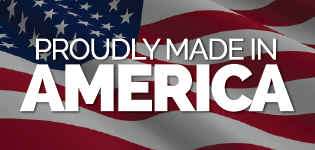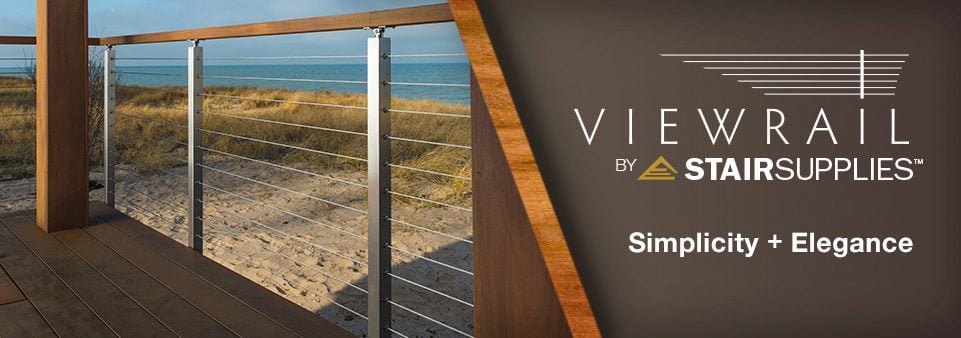About Cable Railing Systems
Cable railing, which has been used commercially for quite some time due to its strength and durability, has been praised and adopted heavily over the years for residential applications as well, and for good reasons. Besides adding a sleek and minimalistic modern-industrial aesthetic, cable is an ideal solution for maximizing visibility around a railing space. Not only is cable significantly slimmer than alternative railing options, but when strung horizontally, it blends seamlessly with the horizon, providing unobstructed views previously unattainable.
What is Cable Railing?
Cable railing, or cable railing systems, offer an alternative to traditional wood or metal stairway railing, in that they use cable rail wire tension for stability, instead of traditional newel posts and balusters. Cable rail offers modern design properties by utilizing metal posts and handrails, but can also be combined with wood stair parts for a hybrid custom style. Stainless steel cable rail is a popular choice for both interior and exterior railing because of its anti-weathering durability, reasonable cost, and strong luxurious appeal.
Types of Cable Railing Systems
Cable can be an ideal railing option for both residential and commercial projects, interior or exterior. A typical system consists of several horizontal runs of cable, spaced within building code requirements and tensioned to a snug yet slightly flexible fit. At StairSupplies, we recommend spacing our 5/32” cable 31/8” apart. The runs of cable are passed through posts as needed both to comply with building code requirements and reduce and eliminate cable deflection. We recommend the spacing between cable railing posts to be no more than 4’. Compatible post materials include stainless steel (we offer 304 and 2205 marine-grade), aluminum, and wood.
While technical distinctions exist between metal and wood systems (such as components used and recommend installation techniques), the primary difference between the two is the overall aesthetic and ambiance. A metal cable rail system with stainless steel posts and handrails exudes an industrial tone, defined by its sleek, minimalistic character. Conversely, when paired with cable, wood posts combine traditional warmth with modern elegance.
Comparison of Metal vs. Wood Cable Railing System
| Features | Metal Cable Railing System | Wood Cable Railing System |
| Style | Modern, Minimalistic | Traditional, Modern |
| Used for Interior Projects | Yes | Yes |
| Used for Exterior Projects | Yes | Yes |
| Ideal for Stairways, Decks, Docks, Patios, and More | Yes | Yes |
| Uses 5/32” 316L Marine-Grade Stainless Steel Cable | Yes | Yes |
| Maximum Space Between Posts | 4’ | 8’ with Intermediate Post Necessary Every 4’ |
| Uses Intermediate Posts | No | Yes |
| Compatible Handrail Materials | Aluminum, Stainless Steel, Wood | Aluminum, Stainless Steel, Wood |
| Compatible Tensioning / Fastening Kits | Level / Angle Tension Kit, Inside Post Mount Kit | DriveTite Kit |
| Fasteners / Tensioners Hidden Within Posts | Yes | No |
Cable Rail System Style and Design
There are three primary reasons why a cable system may be an ideal solution for a stairway or railing; the first of which is to both preserve and enhance the view around a piece of land or area of architecture. You’ve selected and designed a beautiful living space – why clutter the view? Whether a waterfront property with a breathtaking view of the horizon, a cabin tucked away in the mountain forests, or simply a beautiful interior staircase you walk up and down daily, the StairSupplies system ensures all you see is beautiful stainless steel cable – and, of course, your view. This is accomplished through several key design features, such as the concealment of hardware fittings within posts, and using only enough cable and posts to exceed safety and strength requirements.
Another reason cable may be a superior alternative when compared to traditional railing systems is its sleek, modern aesthetic. Whether used with stainless steel posts to achieve an urban style, or hardwood posts to give the space a feeling of natural warmth, cable has a sharp, minimalistic look that traditional railing does not typically offer.
The third reason for which cable railing is often utilized is its natural strength and architectural integrity. Our system’s components are crafted from only the highest quality materials with state-of-the-art machinery, ensuring your railing is preserved for years to come.
Cable Railing for Decks
Cable is a versatile product that makes a fantastic stainless steel deck railing. Because of the strength and rust-resistant nature of our stainless steel, our cable deck railing is both stylish and durable. Including a wooden handrail is a great way to blend your cable deck railing into the natural environment surrounding it. Oftentimes, decks can feel closed off, especially with thick balusters or wooden slats. But installing cable rail on a deck will ensure your deck feels open and spacious. Decks are made so that you can be outdoors, so let yourself enjoy the view!
System Components
While a constructed cable railing system is truly a work of art, the components it’s comprised of are just as innovative and lasting as they are attractive. Our cable and fittings, which are manufactured in the USA, are crafted from 316 marine-grade stainless steel. Our posts and handrails are cut, processed, and finished to order on a daily basis in order to accommodate each project’s unique specifications.
Cable Rail Wire
We’re proud to offer 5/32” 1×19 cable strung from 316L marine-grade stainless steel. Highly resistant against harsh environments, our cable is sure to provide long-lasting strength and beauty.
Cable Railing Posts & Handrails
We strive to offer as many customization options as possible for our cable railing posts and handrails, as these components enable our customers to truly make a unique statement with their design and make their space theirs. Our posts are constructed from aluminum and 304 stainless steel and are available in four distinct post mounting styles, two different top styles, and can be finished with one of our many polishes or colored powder coats.
Our handrails are offered in metal, as well as wood. As with our posts, metal handrails can be produced from aluminum and 304 stainless steel and finished with one of our many polishes or colored powder coats. Conversely, wood handrails are cut from one of our many available species and can be finished with a selection from our wide variety of paints and stains.
Cable Railing Hardware Kits
Crafted in the USA from 316 marine-grade stainless steel, StairSupplies offers several distinct cable railing hardware kits, compatible with metal or wood posts. Unlike other cable railing systems where lengthy tensioners obstruct the view, our hardware is concealed within posts.
Metal Railing Systems
Our Level Tension Kit contains everything needed to tension one end of a level run of cable: A Tension Receiver, a Threaded Crimp Fitting, and a Steel Insert Sleeve.
Similar to our Level Tension Kit, our Angle Tension Kit contains everything needed to tension one end of an angled run of cable: A Tension Receiver, a Threaded Crimp Fitting, an Angle Washer, and an Angled Adhesive Sleeve.
Our Inside Post Mount Kit contains all necessary components to fasten one end of a run of cable from within a post: A Cable Stop, Cable Termination Washer, and an Adhesive Sleeve. The Inside Post Mount Kit is used on the condition that the opposite end of cable is being tensioned, as the Inside Post Mount Kit does not have tensioning functionality; rather, it simply holds the cable firmly in place to allow for tensioning on the opposite end of the cable, leaving the edges of the post with an adhesive sleeve flush with no visible hardware.
Cable Rail Kit for Wood Systems
We offer two distinct kinds of cable railing kits for installing and tensioning cable in wood posts: Angled or Level DriveTite. Our DriveTite kits allow for a particularly simple and painless installation process, and can even be completed with a standard electric drill.
Our DriveTite Kit contained two different kits for a leveled or angled cable system. Use our DriveTite Installation Kit for the installation of this kit, we do recommend utilizing our 5” long T-30 driver to tighten the Tensioning Screw rather than a standard length T-30 driver.
DIY Cable Railing Videos
View 15 related DIY cable railing videos that offer guidance for cable railing installation. Included in this collection are the following videos:
• Level Tension Kit Installation Guide
• Angle Tension Kit Installation Guide
• Cable Railing Installation Kit
• Postside Handrail Bracket Installation Guide
• DriveTite Kit Installation Guide
• DriveTite Kit Installation Tips
• Introduction to our Cable Rail System
• Cable Rail Post Spacing and Cable Deflection
Recent Cable Rail System Projects
View recent cable rail projects sent to us from satisfied customers, who’ve used StairSupplies™ for their cable railing systems. Below features a wide range of different custom cable railing designs, with beautiful craftsmanship.
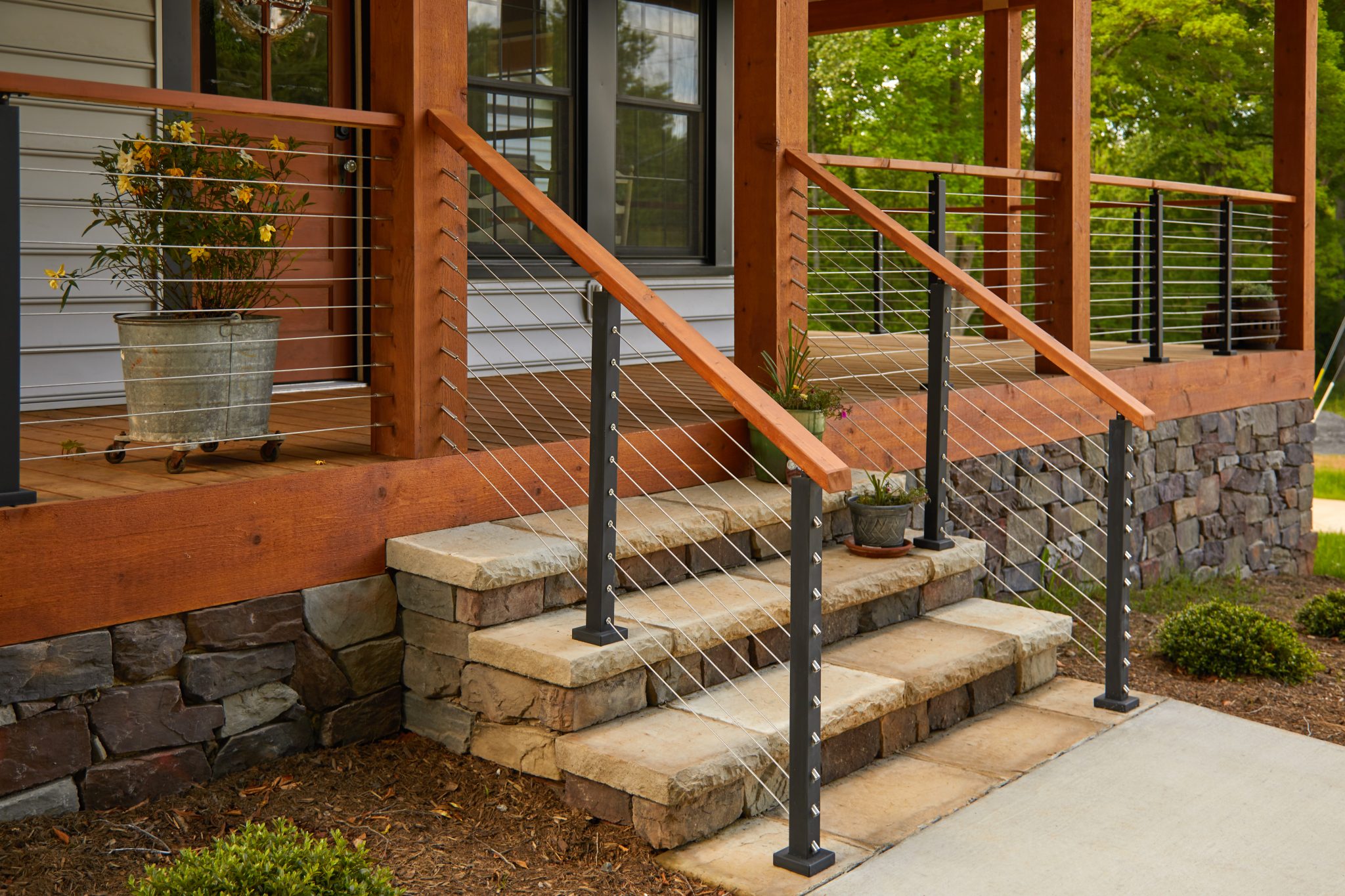
Exterior deck railing utilizing a cable “B” Up post to an Angled DriveTite into an existing Cedar column.
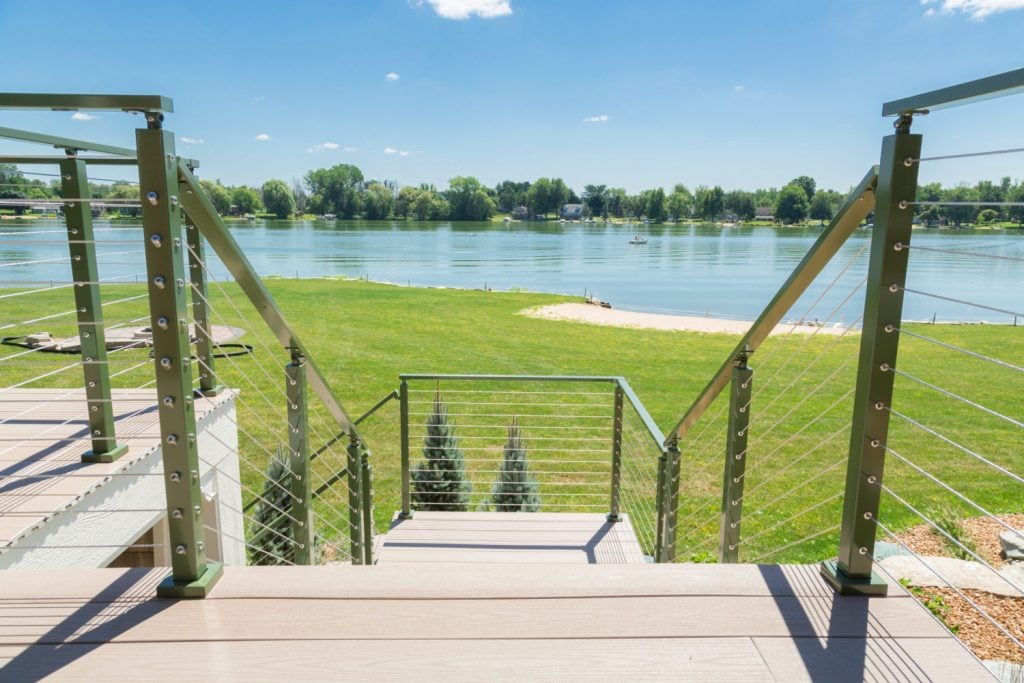
Exterior cable deck railing system with metal posts and railing. This design offers pristine elegance, definitely matched by the beautiful lake view present.
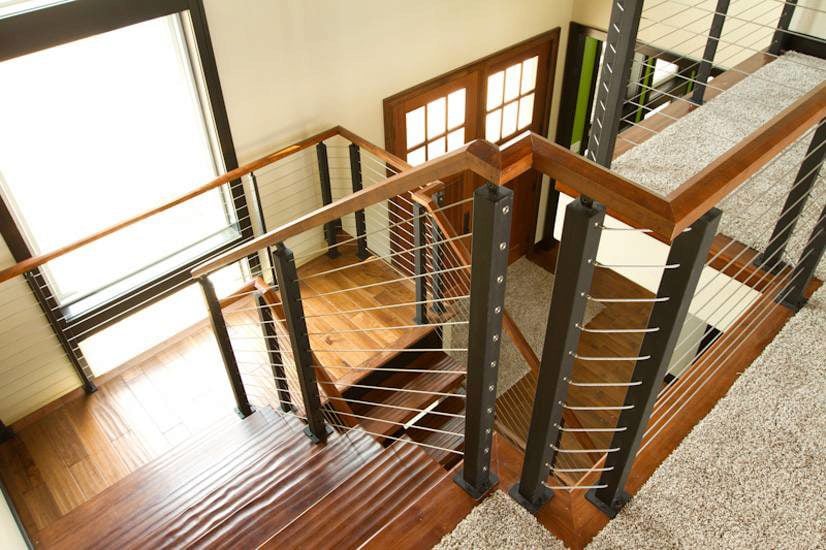
Custom cable railing system with metal posts and wood handrails. This design is combined with wood handrails, engineered wood floors, and even features carpeted flooring above.
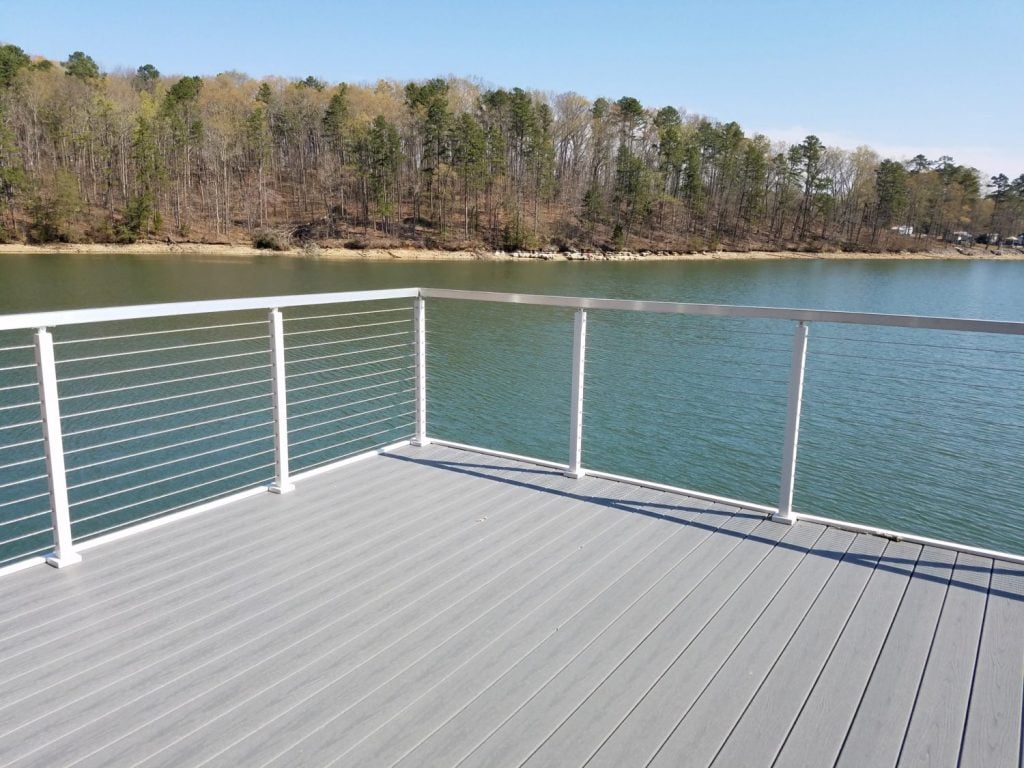
Stainless steel cable railing for decks is commonly used because of the safety and anti-weathering properties offered, while still offering a clear scenic view.
Cable Railing FAQs
Q: What type of Material should I choose for my interior project?
A: For most interior projects we recommend 304 Stainless Steel or Aluminum. For any project within 10 miles of ocean water, we recommend Rod or Glass infill using Aluminum with a fluoropolymer or Endurance powder coat ,or, 2205 Stainless Steel (with a brushed finish). These are more corrosion-resistant options and will require less maintenance than cable.
Q: Can I use Aluminum posts inside?
A: Yes, aluminum posts work well for interior use. We have developed a robust process for powder coating aluminum and can safely recommend them for interior or exterior use.
Q: What type of Material should I choose for my exterior project?
A: For 90% of customers we recommend using either Aluminum or 304 Stainless Steel. For the remaining 10% (which is any project within 10 miles of ocean water), we recommend 2205 Stainless Steel Rods or our glass infill, which we offer in both aluminum and stainless steel posts. We have found that cable in extreme coastal situations will tea stain which requires more maintenance to preserve the finish.
Aluminum is perfect if you’re wanting a powder-coated product (black, white, grey..etc). Aluminum with a Fluoropolymer or Endurance powder coat is one of our strongest, most durable finishes. Stainless Steel can also be powder coated to ensure that you have the strongest base possible, although we recommend leaving Stainless Steel brushed.
Q: Are Insert Sleeves necessary on my intermediate (pass through) posts?
A: No, they are not.
Insert Sleeves give a more decorative & finished look so that your tensioning posts (end posts) and your intermediate posts have a consistent look.
Q: I want to make my own metal posts, what size holes do I need to drill?
A: Both our Level Tension Kit & Angle Tension Kit require 1/2″ holes. If you want to use insert sleeves on intermediate posts, you’d drill 1/2″ holes as well.
For corner posts we recommend using our “Inside Post Mount Kit” and “Level Tension Kit” to give it a finished look.
Q: I’m using existing wood posts, what size hole do I need to drill?
A: Hole size and depth depend on which tension kits and components you are installing. Here’s the breakdown.
Pass-Through Posts
If you are simply running the cable through the post, we recommend using 5/16″ holes.
End Posts
For DriveTite, drill you’ll need to drill a 1/8″ pilot hole for each kit location.
Q: What handrail height should I pick?
A: In most locations code calls for a handrail on stairs to be between 34″ – 38″, therefore we recommend using a 36″ tall system on your stairs.
The code for balconies varies more depending on the location. The most commonly used height is 39″, but for more safety-conscious (and for taller customers), we recommend going with 42″. Please check on your local code requirements before placing an order.
Q: How do I install my posts on a floating staircase?
A: For most projects you can simply use our post mounting screws to fasten directly into the thick tread or blocking. For projects where the tread is too thin, you can use a Post Fastening Plate and 4″ carriage bolt kits to bolt the post onto the tread.
In order to give yourself the cleanest installation we then recommend covering the post foot with a foot cover, this gives the top and bottom of the tread a clean look.
Q: What is the smallest handrail I can use?
A: Our smallest handrail that provides adequate strength is our 1″ tall x 2″ wide Metal Handrail or 1.5″ round handrail. The smallest wood handrail that people select with our cable railing system is our 6100 handrail, which is 1 1/2″ tall x 2″ wide. Our most commonly used handrail is our 6000 handrail, which is 1 5/8″ tall x 2 3/4″ wide. It’s a nice proportion to the 2″ post, and gives it a warmer feeling that our metal handrail.
Q: What’s a typical linear foot price for cable railing?
A: The price varies greatly depending on 3 things: How long of runs you have (how often are you turning corners), what material you want your posts made out of & what type of handrail you select.
However, a general ballpark is between $90 – $180 per foot. Could be more, could be less depending on your specific project. To get an exact quote us our Cable Rail Design Help form.
Q: Do I need to have 10 cables? I think 5 would look nicer.
A: We space our cables at 3 1/8″ so that when tensioned your cables shouldn’t deflect past 4″ (which is code in most areas). There are other factors involved with cable deflection, but if you have a post every 4′, and cables at 3 1/8″ you should meet code.
If for some reason you don’t care about meeting code, you could use fewer cables, however, we don’t recommend this.
Q: Does cable railing pass code? Are cable railing systems considered dangerous because it creates a ladder effect?
A: In most areas of the country if you stick to our recommendations (post every 4 feet and cable every 3 1/8″), cable will meet code. However, there are some local codes that require you to install a thin layer of Plexiglas beside the cable, in order to eliminate the ladder effect. This is becoming less and less common as we begin to understand the safety of properly designed cable railing system.
We recommend checking with your local code office before placing your order.
Q: Do you offer round posts?
A: We do not offer round posts. They are not able to be used in corner applications, and therefore the system becomes much busier and more expensive.
Q: Do your components work for round posts?
A: Our Level Tension Kits will work (although the fittings won’t sit flush on the post), the other products we offer typically will not work with round posts. There are some exceptions, but for the most part, our products are designed to work on square posts.
Q: How can I get a price for my cable railing project?
A: The best way that we can help you is for you to fill out our Cable Rail Design Help form. This gives us the information necessary to get you an accurate quote.
Q: What is the difference between 304 Stainless Steel & 2205 Stainless Steel?
A: 2205 Stainless Steel contains molybdenum & additional nickel to be more corrosion resistant to saltwater. 2205 Stainless Steel is what we recommend when you are within 10 miles of the coast. If you’re located anywhere else 304 Stainless will be adequate.
Q: What is the difference between Brushed Stainless & Electropolished Brushed Stainless?
A: For Brushed Stainless we manufacture the products with a sanding process in order to give it a premium brushed look. We recommend you use our Brushed Stainless on our Stainless Steel posts and powder coat finishes on our Aluminum posts.
Stainless Steel is not stain resistant, but it will Stain LESS than normal steel.
Cable Railing Articles
How to Install Cable Railing Systems
The Latest In Stair Design Trends
Tools and Supplies You Need for Cable Rail Installation
How to Utilize Internal Cable Rail
Excellent External Cable Rail Projects
4 Reasons To Use Stainless Steel Cable Rails
Making Cable Rail Easy
Improving Your Deck With Stainless Steel Cable Rails


